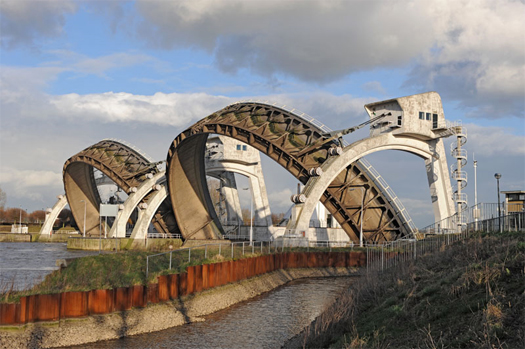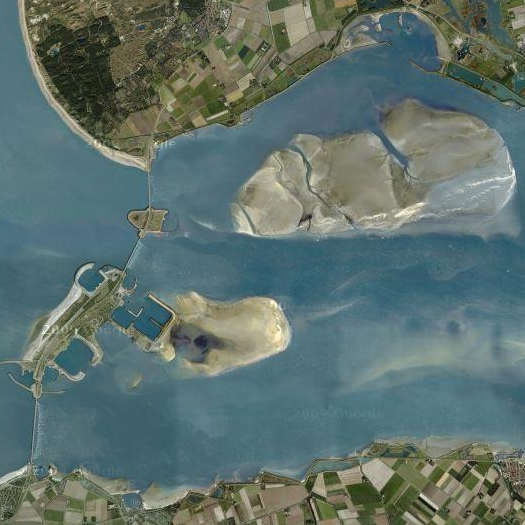Louisiana senator Mary Landrieu, returning from a tour of the Netherlands’ coastal armaments, says America needs to “rethink its entire approach to low-lying coastal areas and adopt an integrated model of water management like that of the Netherlands.” Here at mammoth, we (of course) think that this is a fantastic idea, and not only because (as Americans) we are intensely jealous of the Delta Works and Zuiderzee Works.

Much as Landrieu’s enthusiasm for the reconstruction of America’s coastline stems from the catastrophic landfall of Hurricane Katrina, the Dutch system descends from a traumatic national encounter with the sea. The North Sea flood of 1953 caused severe damage in both England and the Netherlands, killing nearly 2000 in the Netherlands alone as tens of thousands were forced to evacuate their ruined homes. Nearly a tenth of the Netherlands farmland was inundated, while “icy waters turned villages and farm districts into lakes dotted with dead cows”.
In response, the Dutch devoted themselves to the construction of a systematic series of barriers and accomodations that would protect the land and the people: the integration of water management into urban planning, “taking into account parks and other open spaces that could function as safety reservoirs in case of floods”, incorporation of barrier islands and wetlands into the flood management system, and a sprawling system of 8,060 miles of outer-sea dykes, river dykes, and canal walls. The largest component of this system, the Delta Works, is a series of dams, sluices, locks, dikes, and storm surge barriers which required forty-seven years to complete.

Landrieu explains that the Dutch system is superior both in its integration into the landscape — as mentioned above, parks and open spaces serve as flood reservoirs, while the more modern portions of the Dykeworks are designed to allow the mixing of fresh and salt water that sustains fragile estuary habitat — and sheer weight of structure dedicated to firming the line between sea and land. Perhaps this seems slightly paradoxical, as this implies at once acknowledgement of the necessity of accepting the ambiguity of the relationship between land and water at the coast (which is not so much a line as an average drawn from unstable data points) and a far more serious effort at crystallizing that line through the construction of megastructures. But the flexibility to hold these two contradictory stances in tension maybe exactly the flexiblity that the Army Corps of Engineers needs to develop. The Dutch example may even suggest that an architecture of flexible insertions that reprogram the radical flux of natural systems and an architecture of mammoth bulwarks against that radical flux are not wholly incompatible.
Perhaps the twentieth century Corps of Engineers and James Corner do not present so divergent a set of futures for infrastructure? Could the “integrated model of water management” that Landrieu refers to mean not the merely the adoption of a new paradigm that sees storm and water as a resource (or essential component of the whole), but the integration of that paradigm with the old paradigm of opposition between human and nature, creating a new perspective neither reductive nor naive?

I don’t mean to imply that the Dutch have found the perfect balance between paradigms. The building of the Deltaworks has involved its fair share of missteps, such as the collapse of shad populations in the Rhein and the obliteration of the shellfish population of the Grevelingen sand flats. But the semi-accidental production of wetland habitat in the Oostvaardersplassen or the relative stability of biological community of the Oosterschelde estuary suggest that, even if there is no static and permanent balance point to be found, infrastructures that would tower over Louisiana’s current defenses may be able to coexist with more flexible flood management strategies. It may even be, as Mary Landrieu suggests, essential that they do.
[Guardian article on Sen. Landrieu’s visit to the Netherlands via lewism]


Great post that I wish I’d written myself, one thing to add is that the whole of Dutch landscape and history can be seen as a kind of resistance to and acknowledgement of the sea. The polder system which is on the surface just a land reclaimation sytem, is for a Dutchman something more. A political sytem, an ownership structure, a landscape. As your post so well implies to bring this to the u.S. is more than just to implement some mega projects and some planning rules but reconcieve how land and water thought of.
[…] mammoth took this post and wrote an excellent article about the Dutch water management system, bulwarks and flux. This entry was posted in Environment and tagged netherlands, usa. Bookmark the permalink. Post a […]
Thanks, Lewis. That is a great point, which reminded me of something I had read recently, in an article in the NYTimes Magazine:
Obviously this history of collective action in response to the sea does not exist in the States, and any adaptation of the Dutch experience to the US flood control system ought to be done with an awareness of how differing historical experiences inform present conditions.
(Thanks for reminding me where I had read that, Stephen).
[…] long as I’m on the subject of urban parks that serve as components of flood management systems, I ought to mention the recent […]
[…] and the vanished lakes of Mexico City, wondering whether the Netherlands provides an example of the coexistence of rigid and flexible strategies for flood management, and on bayous, floods, and indeterminacy in […]
[…] (to own a piece of what Habermas or Ellul would call ‘technique’), we’ve ceded the big picture (and, with it, the really interesting work) to the accidental whims of the engineers (experts in […]
[…] of stormwater infrastructure and public parks being previously praised by mammoth in both Texas and the Netherlands. Waterpleinen is featured in the latest issue of Alphabet City, Water. Read Christie […]
[…] fascinating oddities and, apparently, endless mammoth posts on Dutch hydrology. As lewism noted on one such post, Bulwarks and Flux: …the whole of Dutch landscape and history can be seen as […]
[…] about bulwarking, the act of rambling through monumental flood protection infrastructure? Should be popular […]
[…] 2. bulwarks and flux […]
[…] Mississippi Delta, American politicians, engineers, planners, and designers have, with good reason, looked to the Netherlands for inspiration and […]